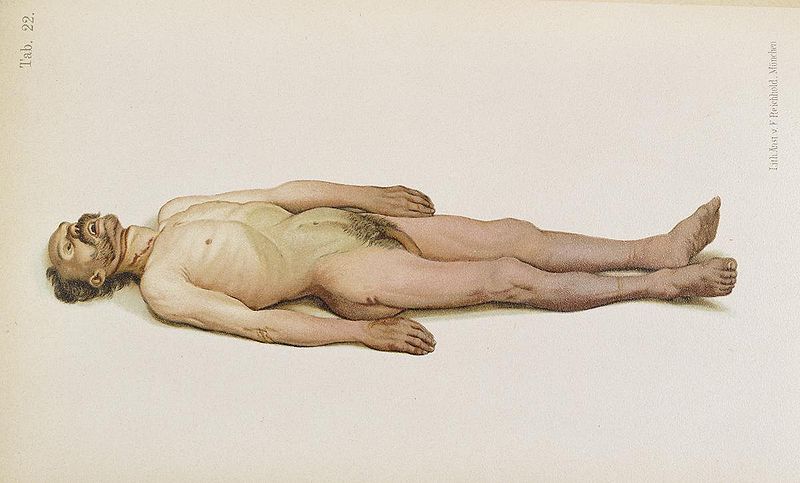Suicide by Hanging

Taken from "Lehrbuch der gerichtlichen Medicin." ("Atlas of Legal Medicine") Vienna, 1878. By Eduard Ritter von Hofmann (1837-1897). Suicide by hanging; suspension of the body for several days; peculiar distribution of the hypostases.
Body of an unknown man, aged about 60 years, found hanging to a tree in the Dornbach forest, October 30, 1896.The normally brunette skin, through the imbibition of bloody serum, has assumed a dirty violet color. The skin of the face, of the neck, and of the upper part of the body as far as the waist is pale ; below this region, increasing in intensity downward, it is of a dirty violet color ” the discoloration reaching its highest grade in the feet. The discoloration is diffuse ; only here and there can one distinguish fading, punctiform, reddish spots. These are made up of the minutest ecchyinoses, and because of their small size are not depicted in the illustration. A similar discoloration is also discernible in the dependent arms. The skin of the upper arms is pale, but below it becomes more and more livid, so that the hands and fingers show a markedly dirty violet color.
This bilateral, symmetrically distributed discoloration of the skin is the result of the long-continued perpendicular position of the body. As a consequence of this the external hypostases (the so-called post mortem lividity) have not developed (as usually) on the posterior surface of the body, but in the lower dependent portions thereof.
Such distribution of the postmortem lividity, when found in a body, by no means indicates that the deceased died as a result of hanging; it may also develop when a body is hung up. It merely indicates that the body was hanging for a long time. But from the degree of the development of this phenomenon, in connection with other postmortem findings, one may approximately conclude how long the body was suspended.
In the present case, despite the low temperature in the forest, the abdomen was already putrescent” green ; the serosanguinolent imbibi tion of the hypostatically discolored parts, as well as of the rest of the skin, was well advanced ; the eyeballs were much depressed and relaxed. It was in consequence concluded that the body must have been hanging about a week or at least several days.
There was no question as to the case being one of suicide by banging. The groove produced by the rope, which was 1 cm. thick and old, is dried and leather-like. At the front of the neck it is directed transversely between the larynx and the hyoid bone ; on both sides alike it ascends behind the mastoid processes of the temporal bones to the nape of the neck, where it terminates in the hair. Excepting this groove, no injury was found either internally or externally ; in particular no indications of violence could be discovered.
To the right side of the neck in its lower part, however, there were found three brownish, dried, irregular, linear spots. They affect only the upper layers of the skin, are not associated with any deeper injuries, reveal no indications of reactive phenomena, and may therefore be looked upon as having probably developed postmortem.
There were no striking evidences of congestion or ecchymoses of the face. This is readily explicable because of the symmetric arrangement of the rope, which gave rise to a sudden, equable compression of the various vessels of the anterior part of the neck.